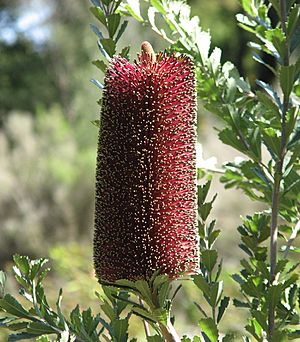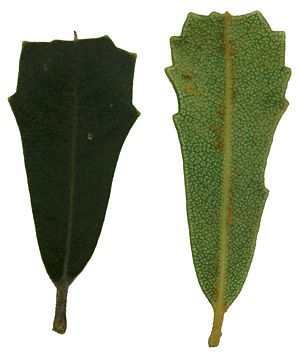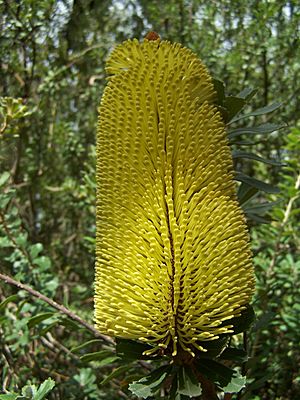Cut-leaf banksia facts for kids
Quick facts for kids Cut-leaf Banksia |
|
|---|---|
 |
|
| Scientific classification | |
| Kingdom: | |
| (unranked): | |
| (unranked): | |
| Order: | |
| Family: | |
| Genus: | |
| Subgenus: | |
| Section: | |
| Series: | |
| Species: |
B. praemorsa
|
| Binomial name | |
| Banksia praemorsa |
|
| Synonyms | |
|
Banksia marcescens R.Br. |
|
The Banksia praemorsa, also known as the cut-leaf banksia, is a type of shrub or small tree found in Western Australia. It belongs to the famous Banksia plant family. You can find it growing in a few special spots along the south coast of Western Australia. These areas are located between the towns of Albany and Cape Riche.
What Does It Look Like?
The cut-leaf banksia usually grows as a shrub. It can reach about 4 meters (13 feet) tall. It has a strong, thick trunk that often branches out close to the ground. Sometimes, it can even grow taller, up to 6 or 7 meters (20 to 23 feet) high! Its trunk can be quite wide, around 30 to 40 centimeters (12 to 16 inches) across. The bark on its trunk is rough and flaky.
This plant flowers from August to November. Its flowers grow in tall spikes. These spikes can be up to 27 centimeters (11 inches) tall. They are made up of hundreds of tiny flowers all packed together on a woody stem. Even though they grow at the ends of branches, they are often hidden by the leaves.
How It Got Its Name
The cut-leaf banksia was first described by an English plant expert named Henry Cranke Andrews in July 1802. He studied a plant growing in a special garden. The seeds for this plant were collected by Archibald Menzies in Western Australia back in 1791.
The scientific name praemorsa comes from a Latin word meaning "bitten off." This name was chosen because of the unique shape of the ends of its leaves, which look like they have been bitten off!
Scientists group plants together based on their features. This helps us understand how different plants are related. The cut-leaf banksia is part of the Banksia genus, which includes many other types of banksias.
Where It Lives
The cut-leaf banksia grows in small, separate groups along the south coast of Western Australia. It likes to live very close to the ocean, usually within 2 kilometers (1.2 miles) of the coast. You can find it on sand dunes, sandy cliffs, or hills that are made of limestone and face the sea. In these areas, it rains about 800 millimeters (31.5 inches) each year.
Growing This Plant
The cut-leaf banksia can be grown in gardens, but it doesn't like humid summers very much. If you plant it from a seed, it usually takes about 4 to 5 years for it to start flowering. There's a special type of cut-leaf banksia that has all-yellow flowers, and it's quite popular to grow. Some of these have grown as tall as 9 meters (30 feet)!
This plant can grow in different types of soil, from slightly acidic to slightly alkaline. It needs good drainage, meaning the water should not sit around its roots. It also likes to grow in a sunny spot. If you want to grow it from seeds, you don't need to do anything special to them. They usually sprout in about 30 to 49 days.
See also
 In Spanish: Ipecacuana antípoda para niños
In Spanish: Ipecacuana antípoda para niños



